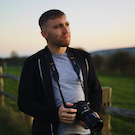Leaderboard
Popular Content
Showing content with the highest reputation on 10/31/2017 in all areas
-

Audio for talking heads - on a budget??
Mark Romero 2 and 2 others reacted to Drew Allegre for a topic
I picked up an Octava Mk-012 on ebay (and yes, I researched the Chinese fakes). It was supposed to be the "movie" kit with a hyper, but it came with a cardioid. Still sounds pretty damn good to me in my tiny little 8x10 room that I call my office. But I'm going to send it back or sell it, because I found another one on ebay with all three capsules for $200, and I had to jump on that. Should have it by next week. So, my audio kit has gone from basically an H4n and whatever I can borrow to a Zoom F4, UWP-D11 kit, and the Mk-012. Total expenses including cables, a decent pair of headphones, and a few odds and ends = $1300. I'm confident that this project is going to sound significantly better than it would have with an H4n and AT875r. Thank you folks! The back and forth has actually been helpful. Lots of things to consider from a lot of different perspectives.3 points -
Same Anamorphot-40 compact combo... (+ Mavic too)2 points
-
The correct way to expose for SLOG3 when using 8bit cameras
TheRenaissanceMan and one other reacted to jax_rox for a topic
I rarely encounter banding on my A7s and A7sII. What were you shooting? How were you grading? I'd be interested to see examples of banding given I've not experienced it, yet you seem to find it so bad to the point of unusable... As you've sort-of covered... it isn't overexposure necessarily. Knowing the curve and where it places its values is extremely important when shooting log. Moreso when shooting 8-bit log. Blanket over-exposure won't necessarily give you better results. As for Arri, I regularly rate them at 400. 800 may give you the greatest spread of dynamic range, and results are generally acceptable. I find rating at 400 better. Knowing the curve and placing your exposure properly will give you even better results. Have fun with constantly shifting depth of field and days (and therefore money) in the colour suite trying to get everything to match....2 points -
I wrote and directed this short film for halloween and I'd love some feedback on it if you get a few minutes. Hope you enjoy!1 point
-
Kowa B&H Close Focus Mod & other 'Tweaks'
Juank reacted to mdominic20 for a topic
Here's some tips, based on my experience with the sharpness tweak: I'm not sure if this is the case with every lens, but with mine, it was possible to adjust the sharpness without even removing the brass tabs. Just by loosening all 6 screws, but leaving the tabs in place, it created enough rotational play in the front optic for me to fine-tune the sharpness. This is because the holes in the brass tabs are ever so slightly bigger than the screws, so you have a little room for rotation. For me it was just enough. Once you find the sweet spot, simply re-tighten the screws. No glue needed. Be careful that the act of re-tightneing the screws doesn't nudge the optic. This took me a little while to get right. Once everything is tight, check the image again to make sure it's still sharp. As Tito says in his video, it's easiest to judge the sharpness using a long lens at (or near) infinity, and stopped down to 4 or 5.6. In my case, I could never get a sharp image with the Kowa and taking lens at infinity. I had to focus both lenses slightly less than infinity to get a super sharp image. This is very important, especially if you are using a single-focus solution. Don't blindly trust the infinity marks on your Kowa or your taking lens. You might be able to get a MUCH sharper image by adjusting them slightly under infinity. I'm sure this will vary from lens to lens. Hopefully this helps!1 point -
Lol.....yup. The Gemini can do single SDI, however then you might as well record internally on the C300, except for the clarity of each frame as a photo file. Atomos will give you your generic ProRes file that I consider to be the low-end of this cameras output capabilities. The dual SDI image is worth every penny, even if you transcode it down later, the detail from the original does stay better, since the camera isn't doing that processing with a small onboard computer with time restrictions (recording speed) vs. a editing computer taking its time (1 day export anyone?) That's in 24 or 30fps. The Gemini doesn't do higher framerates, but if you have a recorder that can, the F3 does output 60i.....The new ninja star (2?) does HDMI ProRes, and while not listed in the features, I do see a light indicator for a "i to p" mode in the images....... It will work, but fully built with PL Lens......mine was pretty maxed out. Stability was acceptable, resistance had to be upped to almost locked. Lock tripod properly before letting go no matter what....etc., etc. If you can rent a beefier tripod, it'd be more reliable, while mine has done the job so far. Yup......oops. Colour isn't perfect, only spent an hour or two including picking footage, then colouring, but you'll get the idea. Most of this was shot with no light control, lantern shots had zero lights other than the practical, and lit sets were extremely limited by gear, time, and manpower. Seriously, when 20 ppl get together and I'm the only one who can do camera, DIT, and Lighting? Least they had a dedicated sound guy....would've loved to fire the director.1 point
-

Gear list
EthanAlexander reacted to JordanWright for a topic
Use zoom lenses - your clients won't be able to tell the difference1 point -
Thanks. Actually you got very good results for handheld hyperlaplse. By the way, try Flicker free for your sequence, it would really help to remove some of the flicker and it's very easy to use (just apply the effect in AE and the auto settings work most of the time).1 point
-
Here's an example which mixes a static Canon 700D, a static Panasonic GX85 and a Panasonic GH5 doing the dynamic hyper lapse stuff. It was shot over 2 days (09.00-21.00) and the edit was done over night on the second day so it could be presented to the press at 10.00am the next day! Hence it has had no post production to remove flicker and any changes in lighting etc, there simply wasn't enough time as the site was over an hour or so from my home. The client was extremly happy with the result with it what matters! Key point about the GH5, all the hyper lapse was done by hand with no monopod or tripod! It's amazing what this camera offers in terms of flexibility! OliKMIA's videos are simply top notch!1 point
-

The correct way to expose for SLOG3 when using 8bit cameras
kidzrevil reacted to Rodolfo Fernandes for a topic
Great job @kidzrevil do you mind sharing your S-LOG3 settings with us, or is it just 'straight out-of-the-box'1 point -
The correct way to expose for SLOG3 when using 8bit cameras
hyalinejim reacted to cpc for a topic
One discriminating characteristic of log curves compared to negative is that (on most of them) there is no shoulder. (Well, the shoulder on Vision3 series films is very high, so not much of a practical consideration unless you overexpose severely.) An effect of this lack of shoulder is that you can generally re-rate slower without messing up color relations through the range, as long as clipping is accounted for. Arri's Log-C has so much latitude over nominal mid gray that rating it at 400 still leaves tons for highlights. I don't think any other camera has similar (or more) latitude above the nominal mid point? Pretty much all the other camera manufacturers inflate reported numbers by counting and reporting the noise fest at the bottom in the overall DR. No wonder that a camera with "more" DR than an Alexa looks like trash in a side-by-side latitude comparison.1 point -
FCPX 10.4 with better color correction tools!
Drew Allegre reacted to Axel for a topic
Slowly but surely HDR is noticed by the content consumers. I was in a shopping mall two weeks ago and they had a gigantic HDR-TV, surrounded by SDR-sets with the same video playing: partly nightsky timelapses (the skies on the other screens appeared grey, the stars faded), partly landscapes with sun (looking like flat LOG clips on the SDR-TVs). The audience very clearly saw the difference. As Yedlin had *proven* in his resolution-myths-debunked video, they couldn't have told the difference between HD and UHD. But there is no standard agreed upon, as I understood. How will an 8-bit rec_709 video, no matter the resolution, look on a 3000 nits screen? Will today's solutions ("HDR ready") be considered foul compromises very soon (like the early HDV cameras that were little else than "SD plus" if you see the images with today's eyes)? Or will the said foul compromises be accepted as just enough to make a visible difference, become standard for a long time and allow - for instance - 8-bit 420 to survive another decade? I'd really like to know.1 point -
Primes are fine if you have time to set-up and swap lenses. Great for scripted stuff. Fast-paced work, or work where you only get one go (i.e. documentary etc.) does not lend itself to primes particularly well. There's no reason you can't get something looking just as good shot on a zoom vs a prime.1 point
-
The anamorphic/compact combo is definitely a must have in such light setup, unique of its kind: And the customary darwinfish stuff, even though, his entries always match the pattern as usual -- the news is all this is handheld this time:1 point
-

The correct way to expose for SLOG3 when using 8bit cameras
kidzrevil reacted to EthanAlexander for a topic
@kidzrevil I'm pretty certain what @cpc meant wasn't that you shouldn't ETTR - He's saying in order to keep exposure consistent, rather than just ETTR as much as possible before clipping every time, it's better to overexpose by the same amount every time by rating the film speed lower. I agree - makes batch grading an actual possibility.1 point -
Blade Runner 2049 review (2D and 3D versions)
DamienMTL reacted to TrueIndigo for a topic
Saw Blade Runner 2049 yesterday (no plot spoilers in my observations). This is a generally well-realized near-future sci-fi film, as many of the modern fully-funded Hollywood blockbusters are (this one is estimated as costing between $150-185 million depending on what you read). But it does seem somewhat formulaic, lacking any special distinction or energy. It pays homage to the advertising nightmare rainy city as before, and in the breakers yard wasteland goes for a more Mad Max vibe. But non of it has a truly unique knock-out experience as the earlier film managed with less advanced effects. Seeing Blade Runner in 1982 was nothing short of a cinematic revelation about what was possible, given the commitment of various art departments through sheer force of personality and vision. And since things have moved on so much now (the artistry of the CGI people is incredible), it does not give anything like a new version of that sense of wonder which jolted me in the eighties. The sound design follows the trend of many modern action films in being set at a painfully high level - the sort of film in which just putting a drink down on a table sounds like a firecracker going off, and drawing on a cigarette briefly sounds like a bush fire. On this film, a gun shot was as loud as an huge explosion, taking me out of the story every time because of the discomfort. And this was more easy than it should have been, because the story itself felt confused to me and several times I found myself wondering how much longer the film was going on (never a good sign). Although the trailer gives the impression of a sophisticated fast-paced action thriller, in fact everything takes a long time, and is not particularly worth waiting for. Unfortunately it's not very sophisticated either, with uninspired dialogue. I did actually feel mildly bored, which surprised me - I didn't think they would make that mistake - because the overall drama remained cold and uninvolving. Non of the characters turned out to be anyone I could care for, compared to key scenes in the original, such as when Rachel starts playing a piano (and says: "I didn't know I could play."). With the original the audience felt like crying, in this new one some of the characters cry, but it doesn't ring true. It's a bit like watching a full-on romance movie in which it is obvious there is no chemistry between the two lead actors - all of the humans watching such a movie know it immediately: that these two people are only together because they have been badly cast in a movie. In the same way the new Blade Runner story continues with the theme of what it means to be human in a difficult future world of synthetic people, yet tells it with little show of the humanity which is supposed to be so important. Seeing the original movie in the cinema was a life-changing experience, and I eagerly bought the VHS, then later many versions on DVD, etc-etc. It was a way of keeping in touch with a dream, but I have no interest in watching this one again - in any formats that may exist in the future. I opted to see the 2D version of the film because the movie was shot in 2D - ironically, the 3D version has been synthetically processed to give a 3D effect. It's not that I dislike this movie because I liked the original so much, my reaction would be the same if the original never existed. Because it's a disappointing movie in its own right, though obviously without knowing that I had to see it out of a slight hope there was something of the mesmerizing quality of Rachel's self-realization. But of course there is only one Sean Young.1 point -

GH5 all-i 400Mbs vs ipb 150Mbs frames comparison:
Fritz Pierre reacted to Emanuel for a topic
Not regardless the best settings though... GH5 is a professional camera indeed. Requires know-how and work. There are no miracles straight out the box.1 point -
Audio for talking heads - on a budget??
TheRenaissanceMan reacted to Anaconda_ for a topic
Richard, what do you think you're doing trying to bring rationality into a discussion that's basically turned into 'I'm more of a professional than you' contest.1 point -

Addressing some of the myths around Sony a6300-MINI a7sII??!??
TheRenaissanceMan reacted to IronFilm for a topic
Well, seeing as this thread is titled "...addressing some of the myths around..." let's address some of those with the GH5/MFT! Should stating "lowlight" be enough to rule out the GH5? Of course not! Because it is very likely the GH5's lowlight capabilities is sufficient for the asker's needs. It is good to remember some historical context, remember how excited everyone was about how good the 5Dmk2 was in lowlight? (a camera which I don't regard as superior to a GH1+speedbooster combo) Of course now the 5Dmk2 is seen as being "bad" in lowlight by 2017 standards. But then again the MFT world hasn't stood still either since the original MFT camera the GH1 either, which each model (GH2/GH3/GH4/GH5) taking strides forward in improvements in lowlight since the previous model (that is a lot of steps of improvement! We're up to the GH5 now). Look at this shot at night with the old Panasonic GH2 for instance with only practical lighting: Is it perfect? No. Is it unacceptable? No. I think in this day in age, there is no reason in 2017 to be against any of the current cameras due primarily to its low light capabilities. Unless you're in some niche scenario, such as say you are doing a one man doco of homeless people living in underground sewers?! But even then, I'd happily use say my D5200 with a Sigma 18-35mm f1.8, if that is all I had available to me.1 point -
The GH5 is a fantastic camera, including for timelapse. While @Orangenz already answered most of your question I would add: - Smoothing Expo is not really a thing. AV mode and auto metering on Sony camera works very good though. However past a certain level of darkness the metering module is not working and you'll have to make the change manually. Personally I always lock everything in manual and change the expo manually (first shutter speed and then ISO). You can use Flicker Free which is great to correct minor flickering but for serious work there is only LRTimelapse (there is a free demo version that work with up to 400 frames, which is more than enough for most time-lapses). Otherwise you can try to set the camera in AV mode with auto ISO (and set a limit). - Two hours of battery life in time-lapse mode is not that bad actually. Turn off the screen (in the menu or close it physically) to increase the battery life. You can also reduce the brightness to the minimum. - Use a strong ND filter for daylight stuff, it makes such a big difference in quality. Pick an ND7 or ND10. I did all this video and timelapse with the GH5. Superb camera except for very high ISO stuff like astro. I usually don't like to go over ISO 1600 with it but you can compensate with long exposure.1 point
-

APS-C SPEED BOOSTER MATH
kidzrevil reacted to EthanAlexander for a topic
Yes. For instance, if you were to place a FF, non speed boosted 100mm on either an a6500 or a GH5, you'd tell both cameras to stabilize a 100mm. Same logic goes for speed boosted lenses, where you'd tell either camera the "focal reduced" length, in this case 71mm. Just remember, any FF lens on a MFT will look exactly the same as the same mm MFT lens on a MFT. The only difference in those lenses will be the size of the image circle, but the MFT sensor will only ever see the same smaller portion. Hope this isn't getting complex, so to summarize: Since all you're trying to do is figure out the math to tell the camera what focal length to stabilize, there's actually no need to do any math for the sensor size, JUST the focal reduction. All you've got to do is tell the camera what the "mm" is, and when you add a speed booster (0.71x), you're literally placing a 71mm lens on, whether it's APS-C or MFT.1 point


